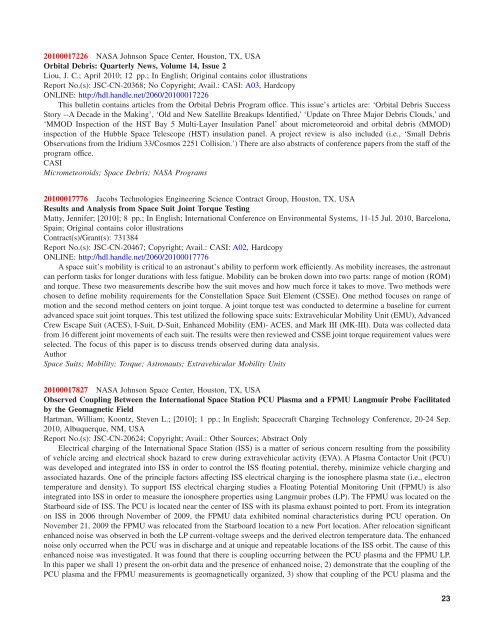NASA Scientific and Technical Aerospace Reports - The University ...
NASA Scientific and Technical Aerospace Reports - The University ...
NASA Scientific and Technical Aerospace Reports - The University ...
Create successful ePaper yourself
Turn your PDF publications into a flip-book with our unique Google optimized e-Paper software.
20100017226 <strong>NASA</strong> Johnson Space Center, Houston, TX, USA<br />
Orbital Debris: Quarterly News, Volume 14, Issue 2<br />
Liou, J. C.; April 2010; 12 pp.; In English; Original contains color illustrations<br />
Report No.(s): JSC-CN-20368; No Copyright; Avail.: CASI: A03, Hardcopy<br />
ONLINE: http://hdl.h<strong>and</strong>le.net/2060/20100017226<br />
This bulletin contains articles from the Orbital Debris Program office. This issue’s articles are: ‘Orbital Debris Success<br />
Story --A Decade in the Making’, ‘Old <strong>and</strong> New Satellite Breakups Identified,’ ‘Update on Three Major Debris Clouds,’ <strong>and</strong><br />
‘MMOD Inspection of the HST Bay 5 Multi-Layer Insulation Panel’ about micrometeoroid <strong>and</strong> orbital debris (MMOD)<br />
inspection of the Hubble Space Telescope (HST) insulation panel. A project review is also included (i.e., ‘Small Debris<br />
Observations from the Iridium 33/Cosmos 2251 Collision.’) <strong>The</strong>re are also abstracts of conference papers from the staff of the<br />
program office.<br />
CASI<br />
Micrometeoroids; Space Debris; <strong>NASA</strong> Programs<br />
20100017776 Jacobs Technologies Engineering Science Contract Group, Houston, TX, USA<br />
Results <strong>and</strong> Analysis from Space Suit Joint Torque Testing<br />
Matty, Jennifer; [2010]; 8 pp.; In English; International Conference on Environmental Systems, 11-15 Jul. 2010, Barcelona,<br />
Spain; Original contains color illustrations<br />
Contract(s)/Grant(s): 731384<br />
Report No.(s): JSC-CN-20467; Copyright; Avail.: CASI: A02, Hardcopy<br />
ONLINE: http://hdl.h<strong>and</strong>le.net/2060/20100017776<br />
A space suit’s mobility is critical to an astronaut’s ability to perform work efficiently. As mobility increases, the astronaut<br />
can perform tasks for longer durations with less fatigue. Mobility can be broken down into two parts: range of motion (ROM)<br />
<strong>and</strong> torque. <strong>The</strong>se two measurements describe how the suit moves <strong>and</strong> how much force it takes to move. Two methods were<br />
chosen to define mobility requirements for the Constellation Space Suit Element (CSSE). One method focuses on range of<br />
motion <strong>and</strong> the second method centers on joint torque. A joint torque test was conducted to determine a baseline for current<br />
advanced space suit joint torques. This test utilized the following space suits: Extravehicular Mobility Unit (EMU), Advanced<br />
Crew Escape Suit (ACES), I-Suit, D-Suit, Enhanced Mobility (EM)- ACES, <strong>and</strong> Mark III (MK-III). Data was collected data<br />
from 16 different joint movements of each suit. <strong>The</strong> results were then reviewed <strong>and</strong> CSSE joint torque requirement values were<br />
selected. <strong>The</strong> focus of this paper is to discuss trends observed during data analysis.<br />
Author<br />
Space Suits; Mobility; Torque; Astronauts; Extravehicular Mobility Units<br />
20100017827 <strong>NASA</strong> Johnson Space Center, Houston, TX, USA<br />
Observed Coupling Between the International Space Station PCU Plasma <strong>and</strong> a FPMU Langmuir Probe Facilitated<br />
by the Geomagnetic Field<br />
Hartman, William; Koontz, Steven L.; [2010]; 1 pp.; In English; Spacecraft Charging Technology Conference, 20-24 Sep.<br />
2010, Albuquerque, NM, USA<br />
Report No.(s): JSC-CN-20624; Copyright; Avail.: Other Sources; Abstract Only<br />
Electrical charging of the International Space Station (ISS) is a matter of serious concern resulting from the possibility<br />
of vehicle arcing <strong>and</strong> electrical shock hazard to crew during extravehicular activity (EVA). A Plasma Contactor Unit (PCU)<br />
was developed <strong>and</strong> integrated into ISS in order to control the ISS floating potential, thereby, minimize vehicle charging <strong>and</strong><br />
associated hazards. One of the principle factors affecting ISS electrical charging is the ionosphere plasma state (i.e., electron<br />
temperature <strong>and</strong> density). To support ISS electrical charging studies a Floating Potential Monitoring Unit (FPMU) is also<br />
integrated into ISS in order to measure the ionosphere properties using Langmuir probes (LP). <strong>The</strong> FPMU was located on the<br />
Starboard side of ISS. <strong>The</strong> PCU is located near the center of ISS with its plasma exhaust pointed to port. From its integration<br />
on ISS in 2006 through November of 2009, the FPMU data exhibited nominal characteristics during PCU operation. On<br />
November 21, 2009 the FPMU was relocated from the Starboard location to a new Port location. After relocation significant<br />
enhanced noise was observed in both the LP current-voltage sweeps <strong>and</strong> the derived electron temperature data. <strong>The</strong> enhanced<br />
noise only occurred when the PCU was in discharge <strong>and</strong> at unique <strong>and</strong> repeatable locations of the ISS orbit. <strong>The</strong> cause of this<br />
enhanced noise was investigated. It was found that there is coupling occurring between the PCU plasma <strong>and</strong> the FPMU LP.<br />
In this paper we shall 1) present the on-orbit data <strong>and</strong> the presence of enhanced noise, 2) demonstrate that the coupling of the<br />
PCU plasma <strong>and</strong> the FPMU measurements is geomagnetically organized, 3) show that coupling of the PCU plasma <strong>and</strong> the<br />
23

















